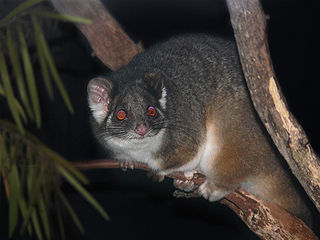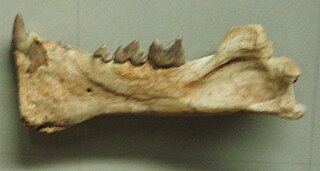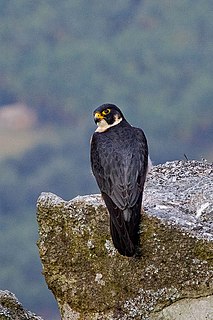Related Research Articles

The peregrine falcon, also known as the peregrine, and historically as the duck hawk in North America, is a widespread bird of prey (raptor) in the family Falconidae. A large, crow-sized falcon, it has a blue-grey back, barred white underparts, and a black head. The peregrine is renowned for its speed, reaching over 320 km/h (200 mph) during its characteristic hunting stoop, making it the fastest bird in the world, as well as the fastest member of the animal kingdom. According to a National Geographic TV program, the highest measured speed of a peregrine falcon is 389 km/h (242 mph). As is typical for bird-eating raptors, peregrine falcons are sexually dimorphic, with females being considerably larger than males.
Peregrine, Latin Peregrinus, is a name originally meaning "one from abroad", that is, a foreigner, traveller, or pilgrim. It may refer to:

The Barbary falcon is a medium-sized falcon about the size of a crow. This bird of prey is mainly resident.

The common ringtail possum is an Australian marsupial. It lives in a variety of habitats and eats a variety of leaves of both native and introduced plants, as well as flowers, fruits and sap. This possum also consumes a special type of faeces that is produced during the daytime when it is resting in a nest. This behaviour is called caecotrophy and is similar to that seen in rabbits.
Peregrinus Proteus was a Greek Cynic philosopher, from Parium in Mysia. Leaving home at a young age, he first lived with the Christians in Palestine, before eventually being expelled from that community and adopting the life of a Cynic philosopher and eventually settling in Greece. He is most remembered for committing suicide after giving his own funeral oration, cremating himself on a funeral pyre at the Olympic Games in 165. By 180 AD, a statue of Peregrinus had been erected in his home city of Parium; it was reputed to have oracular powers.

Petrus Peregrinus de Maricourt (Latin), Pierre Pelerin de Maricourt (French), or Peter Peregrinus of Maricourt, was a 13th-century French scholar who conducted experiments on magnetism and wrote the first extant treatise describing the properties of magnets. His work is particularly noted for containing the earliest detailed discussion of freely pivoting compass needles, a fundamental component of the dry compass soon to appear in medieval navigation. He also wrote a treatise on the construction and use of a universal astrolabe.
Possum may refer to:
Agathobulus of Alexandria, who lived c. 125 AD, was a Cynic philosopher and teacher of Demonax and Peregrinus Proteus.
Theagenes of Patras, was a Cynic philosopher and close friend of Peregrinus Proteus.

Erigeron peregrinus is a North American species of flowering plants in the daisy family known by the common name wandering fleabane.
Astius is a 2nd-century Christian martyr venerated by the Roman Catholic and Eastern Orthodox churches. He was the bishop of Dyrrhachium. According to legend, he was arrested by Agricola, the Roman governor of Dyrrachium, and was tortured to death around 98 AD for refusing to worship the god Dionysius. He was crucified during the persecution of Christians under the Roman emperor Trajan.
The Passing of Peregrinus or The Death of Peregrinus is a satire by the Syrian Greek writer Lucian in which the lead character, the Cynic philosopher Peregrinus Proteus, takes advantage of the generosity of Christians and lives a disingenuous life before burning himself at the Olympic Games of 165 AD. The text is historically significant because it contains one of the earliest evaluations of early Christianity by a non-Christian author.

Prosansanosmilus is an extinct genus of mammalian carnivores of the suborder Feliformia, family Barbourofelidae, which lived in Europe during the Miocene epoch, existing for approximately 0.9 million years .
Tonus peregrinus, the wandering tone, or the ninth tone, is a reciting tone in Gregorian chant.
Pinus peregrinus is an extinct species of pine in the family Pinaceae known from Clarkforkian age Paleocene fossils found in western North Dakota, USA.

The shaheen falcon is a non-migratory subspecies of the peregrine falcon found mainly in the Indian subcontinent. It has also been described as a migratory subspecies. Other common names for the subspecies include the black shaheen and Indian peregrine falcon. The word shaheen in these names may also be spelled as shahin. This species was termed as the black shaheen by falconers to separate it from the true shaheen of Persian literature. Scholars of Persian and the Russian ornithologist Georgi Petrovich Dementiev have noted that the name shaheen in Persian literature actually referred to Falco peregrinus babylonicus.
Tiberius Pollienus Armenius Peregrinus was a Roman senator who was appointed consul in AD 244.
Prosansanosmilus peregrinus belongs to the genus Prosansanosmilus in the extinct family Barbourofelidae. It died out in the Miocene epoch.
Meine Seele erhebt den Herren is Martin Luther's translation of the Magnificat canticle. It is traditionally sung to a German variant of the tonus peregrinus, a rather exceptional psalm tone in Gregorian chant. The tonus peregrinus is associated with the ninth mode or Aeolian mode. For the traditional setting of Luther's German Magnificat that is the minor mode for which the last note of the melodic formula is the tonic, a fifth below its opening note.

Thaumastocoris peregrinus, the bronze bug, is a true bug first described from Argentina, but is probably native to Australia. The species has been recorded in Africa, Europe, Middle East (Israel), North America, South America, Caribbean, and New Zealand as a pest of eucalyptus.
References
- ↑ St. Peregrinus Catholic Online
- ↑ (in Greek) Ὁ Ἅγιος Περεγρίνος Ἐπίσκοπος Τέρνι. ΜΕΓΑΣ ΣΥΝΑΞΑΡΙΣΤΗΣ.
| | This article about an Italian saint is a stub. You can help Wikipedia by expanding it. |